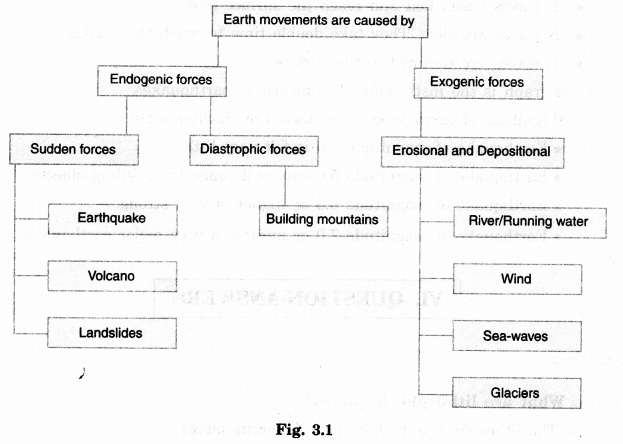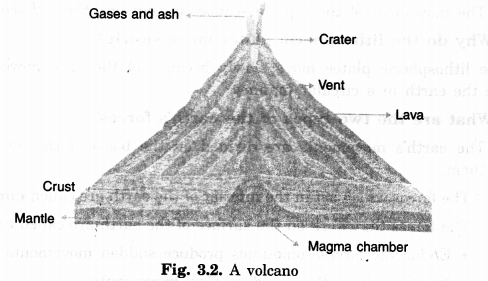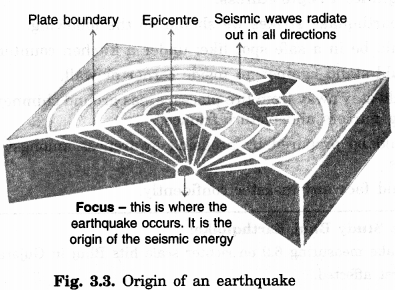Our Changing Earth Class 7 Extra Questions Social Science Geography Chapter 3
NCERT Extra Questions for Class 7 Social Science Geography Chapter 3 Our Changing Earth
Prelude
- The lithosphere is broken into numerous pieces.
- These big pieces are called lithospheric plates.
- The earth’s crust consists of several large and small, rigid, irregularly shaped plates/pieces.
- The movement of these plates causes changes on the surface of the earth.
- The earth’s movements are divided on the basis of the forces which cause them.
- The forces which act in the interior of the earth are called endogenic forces.
- The forces that work on the surface of the earth are called exogenic forces.
- Endogenic forces sometimes produce sudden movements.
- At other times they produce slow movements.
- Sudden movements are earthquakes and volcanoes.
- They cause mass destruction over the surface of the earth.


- When the lithosphere plates move, the surface of the earth vibrates.
- The vibrations travel all around the earth.
- These vibrations are called earthquake.
- Vibrations travel outwards from the epicentre as waves.
- Greatest damage occurs closest to the epicentre.
- The strength of the earthquake decreases, going away from the centre.

- P waves or longitudinal.
- S waves or transverse waves.
- L waves or surface waves.
- Earthquakes cannot be predicted.
- Their impact can certainly be minimised if we are prepared before hand.
- Wild animal behaviour.
- Agitated fish in the ponds.
- Snakes coming out to the surface from their holes.
- Animals trying to untie themselves and run away.
- Birds leaving their nests and beginning to chatter loudly.
- Aborigines beginning to run to higher grounds.
- An earthquake is measured with a machine.
- It is called a seismograph.
The magnitude of the earthquake is measured on Richter scale.
- An earthquake of 2.0 or less is felt only a little.
- An earthquake over 5.0 causes damage from things falling.
- A 6.0 or higher magnitude is considered very strong and 7.0 is classified as a major earthquake.
- We should be in a safe spot like: under a kitchen counter, table or desk.
- We should stand against an inside comer or wall.
- We should stay away from fire places, areas around chimneys, windows that shatter including mirrors and picture frames.
- We should be prepared by arousing awareness amongst our friends and family members.
- We should face any disaster confidently.
NOTES: Case Study Bhuj Earthquake:
- An earthquake measuring 6.9 on richter scale hits Bhuj in Gujarat.
- Schools worst affected.
- Communication water power supply affected
- Hundreds of fire started
- Emergency declared and CM appeals for help.
Major Land Forms
- Weathering and erosion.
- Weathering is the breaking up of rocks on the earth’s surface.
- Erosion is the wearing away of the landscape by different agents like water, wind and ice.
- The eroded material is carried away or transported by water, wind etc.
- They deposit material eventually.
- This process of erosion and deposition creates different landforms on the surface of the earth.
Work of a River
- Running water in the river erodes the landscape.
- When the river tumbles at steep angle over very hard rocks or down a steep valley side, it forms a waterfall.
- When the river enters the plain it twists, turns and forms large bends. These bends are known as meanders.
Due to continuous erosion and deposition along the sides of the meander, the ends of the meander loop come closer and closer.
- In due course of time the meander loop cuts-off from the river and forms a cut-off lake.
- It is called an ox-bow lake.
- At times the river overflows its banks.
- This leads to the flooding of the neighbouring areas.
- The flood water deposits layers of fine soil and other material.
- They’are called sediments, along its banks.
- This leads to the formation of a flat fertile land called a flood plain.
- The raised banks are called levees.
As the river approaches the sea, the speed of the running water decreases.
- The river begins to break up into a number of streams. They are called distributaries.
- Now the river becomes so slow that it begins to deposit its load.
- Each distributary forms its own mouth.
- The collection of sediments from all the mouths forms a delta, the triangular shaped land mass.
Work of Sea Waves
- Erosion and deposition of the sea waves form coastal land forms.
- Sea waves continuously strike at the rocks.
- Cracks develop.
- In course of time they become larger and wider.
- Hollow like caves are formed on the rocks.
- They are called sea caves.
- As caves become bigger and bigger only the roofs of the caves remain. This leads to formation of Sea arches.
- Continuous erosion breaks the roofs and only walls are left.
- These wall-like features are called stacks.
- The steep rocky coast rising almost vertically above sea water is called sea cliff.
- The sea waves deposit sediments along the shores.
- This leads to formation of sea beaches.
Work of Ice
- Glaciers are “rivers” of ice.
- They too erode the landscape by bulldozing soil and stones to expose the solid rock below.
- Glaciers carve out deep hollows.
- As the ice melts they get filled up with water and become beautiful lakes in the mountains.
- The material carried by the glacier like big and small rocks, sand, silt gets deposited.
- These deport from glacial moraines.
Work of Wind
- They are commonly called mushroom rocks.
- Winds erode the lower section of the rock more than the upper part.
- Such rocks have narrower base and wider top.
When the wind blows, it lifts and transports sand from one place to another.
- When it stops blowing, the sand falls and gets deposited in low hill like structures.
- These are called sand dunes.
When the grains of sand are very fine and light, the wind carries it over very long distances.
- When such a sand is deposited in large areas, they are called loess. Large deposits of loess are found in China.
Objective Type Questions

Multiple Choice Questions
Prelude
Major Land Forms
Work of a River:
Work of Sea Waves
Work of Ice
Work of Wind










